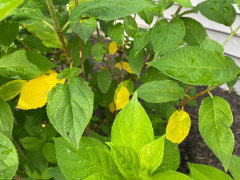Getting The Hydrangea Leaves Turning Yellow To Work
Top Guidelines Of Hydrangea Leaves Turning Yellow
Table of ContentsHydrangea Leaves Turning Yellow Things To Know Before You BuyHydrangea Leaves Turning Yellow Things To Know Before You BuyGet This Report about Hydrangea Leaves Turning YellowSome Ideas on Hydrangea Leaves Turning Yellow You Need To Know
Large fallen leaves usually look droopy during the afternoon heat. When they fail to perk up in the night or still look shrivelled in the early morning, your plant could be overwatered.Get rid of the plant from the soil and trim out any kind of roots that aren't white and swollen (plump). Replant in a brand-new area or work some sand right into the soil for better drain.
Add a little pure water, mix the components, and drain pipes the added water. Put a p, H testing strip in and wait for an analysis. Alternatively, you can use an inexpensive wetness and ph screening meter which will also come in handy later on when you intend to check your plant for underwatering and overwatering.
The finest method to do that is with soil amendments. Sphagnum moss or peat moss prevents the dirt from compacting and betters soil drain while also raising the soil's acidity. You can spread sulfur chips in your hydrangea soil. Nevertheless, the easiest method is to merely utilize a plant food that helps keep the right level of acidity in the soil while also feeding the plant.
Some Known Questions About Hydrangea Leaves Turning Yellow.
This is one great factor to repot houseplants regularly (though there are others, such as origin growth as an example). It is likewise why houseplants call for a much more stringent feeding regular than most outdoor plants. When a hydrangea houseplant is deficient in nutrients, its leaves will certainly be the first to show the indications.

You will also require to feed the plant manually and routine periods. When springtime starts in March, it's the active growing season for lots of houseplants, consisting of hydrangeas.
The dripline is the location situated under the vegetation that is the furthest away from the facility of the plant. So as opposed to using feed to the facility of the plant it is best to concentrate it mainly in the outer locations of the pot. If you prefer to use a slow-release fertilizer such as granular or spike fertilizer, after that cover either type with some soil after you insert them.
The Best Guide To Hydrangea Leaves Turning Yellow

Although the hydrangea is remarkably frost-resistant, when temperature levels begin entering the 20s, the plant remains in major threat. If the temps remain in the low 10s, that threat is extra severe still. Certainly this is even more of a worry about exterior plants so if you maintain potted hydrangea outside you should bring them inside in really winter problems or also take into consideration transferring them inside for the period of the winter season.

A dried hydrangea, A big trouble with numerous houseplants is origin rot. Root rot takes place when you overwater a plant and because it is such a common trouble (particularly with succulents) many houseplant proprietors are afraid of overwatering their plants. Nevertheless, hydrangeas require more watering that the majority of other common houseplants and can end up being dried out when they are underwatered (Hydrangea Leaves Turning Yellow).
Some Known Factual Statements About Hydrangea Leaves Turning Yellow
Be absolutely sure that your hydrangea is dried out due to a lack of water and not due to it be offered too much water (extra site on this later). Overwatering is a major trouble if you cut corners on its water requirements also a little bit, your hydrangea will be quick to reveal it.
The most effective way to identify if your hydrangea is undersea is to examine the dampness levels in the soil. By utilizing a reliable yet affordable wetness and p, H tester, or by sticking your finger into the soil, you will promptly tell if the plant requires water. To obtain your hydrangea sprinkling habits on the right track, you need to be mindful regarding the dampness degrees in its soil.
When you eliminate your finger from damp dirt it will have percentages of soil deposit adhered to it. Dry soil will certainly indicate your finger comes out tidy or with dry soil that is quickly surprised. If it's moist, and the plant has yellow leaves then the plant has actually likely been overwatered and you will certainly require to adhere to the suggestions given up the section below.